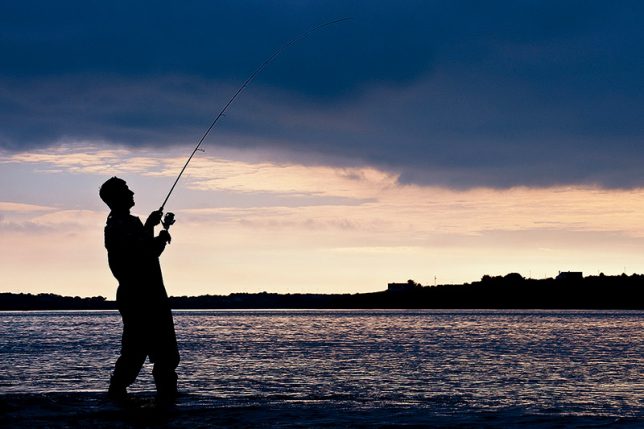CHAPTER 3 – TECHNIQUES – LURE FISHING
Redgills From The Shore
Most of my fishing is from the shore at the mouth of the river Teign, the remainder being at rocky marks around Torbay. Over 90 per cent of my fish come from the Teign, and I seem to have that venue cracked in terms of a particular method which I have tried to perfect for this venue and so far the results are very encouraging.
I find that the best times for this method are July, August and September, with a medium tide range and a light prevailing wind. Big tides are too powerful; for control of a smooth swimming action of the lure, and moderate winds mean a bow in the line and missed takes. Fish LW-1 hour to LW+2 hours.

The line is 18lb braid which goes through a sliding 1/2 to 1 oz in-line weight, a white bead and is tied to a swivel. The other side of the swivel has a fluorocarbon trace of 1 to 1.5 meters terminating with a 115mm pearl-bellied Redgill. I buy batches of pearl coloured Redgills and colour their topsides anywhere between British racing green and dark brown.
Retrieve speed is critical, generally much slower than one might expect. Tackle losses are inevitable although reduced with the use of a very light, tippy rod that allows one to distinguish between weed, bite and rocks. An average session results in two to six bass with two or three lost Redgills – initially more losses were common. My best session in one year was 26 bass up to 4lb 6oz.
Live sandeels work well and are usually available locally but are often taken deeply by small bass making it difficult to return them unharmed. The general size of capture using live sandeel is in fact smaller, due to the lighter casting (so as not to injure the sandeel), meaning a smaller casting radius. Experience has shown that it is a fallacy that large fish will only fall to live sandeels – I have hooked and landed up to 6-pounders on Redgills.
Small spinners can work but only when there are a lot of sprats about (August/September).
Fish caught on a small Redgill are usually scissor or lip hooked. Those that have run on to the eel and are subsequently hooked behind a gill plate can be easily released by pushing the eel out through the gill opening and cutting the line. Light pressure behind the gills causes the bass to flare its gills so that there is minimal effort and scratchy maneuvering of the eel through the actual gill.
So there it is, a method of using Redgills from the shore. Maybe it can work for you in another sandy estuary.
Author: Peter Badcock
Historical note: This article is an extract from a letter published in BASS magazine no.100 Winter 2001
© Bass Anglers’ Sportfishing Society 2008